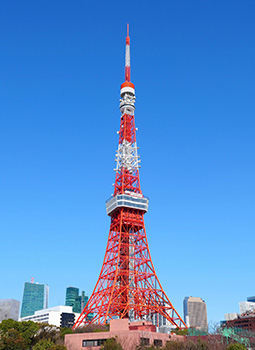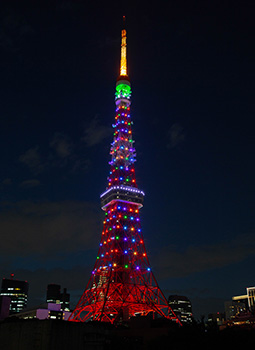
Tokyo Tower 
Tokyo Tower, illuminated
July 2020
Tokyo Tower: Beloved Symbol of the Capital

The freestanding orange-and-white lattice tower is for many people the defining image of Tokyo. Even after more than sixty years since its completion, Tokyo Tower remains a beloved symbol of the capital for those who live and work beneath its ever-changing skyline.

In December of 2020, the Japan Radio Tower, known as Tokyo Tower and located in Minato City, will celebrate its 62nd anniversary since opening. When it was completed in 1958, at 333 meters it was the tallest free-standing steel tower in the world. In 1953, once television broadcasting began in Japan, each broadcasting company built their own broadcasting towers, but with further new entrants projected, it became necessary to have a combined tower from which all television signals could be transmitted. The person who pioneered the project to build an enormous broadcasting tower that would also include an observatory to earn revenue from tourism was Maeda Hisakichi (1893–1986), who was the president of a newspaper company in Osaka at the time and later went on to establish the Nippon Television City Corp. (now Tokyo Tower Co., Ltd.). He believed that it was essential to build the world’s tallest tower, surpassing even the Eiffel Tower in Paris, not only to allow the signal to be broadcast across the entire expansive Kanto Plains, but also to bring in many tourists.
Since immediately after the completion of Tokyo Tower, around 10,000 people have visited it every day and in some years the annual number of visitors reaches nearly four million. Japan was right in the middle of a period of high economic growth at the time of its construction, and Tokyo Tower became a symbol of Japanese growth along with the 1964 Tokyo Olympics and the Shinkansen bullet train. At the time, there were no high-rise buildings like there are now, so it was possible to see the sight of Tokyo Tower from all across the city, as if it were piercing the sky. Before long, Tokyo Tower came to be a symbol of Tokyo and a part of Tokyoites’ mental image of the city. The tower is illuminated at night and its beauty has captured the hearts of many. It appears in many movies and TV shows, and Tokyo Tower itself even shows up in some of their titles. Tokyo Tower was registered as a national registered tangible cultural property in 2013, and in Minato City, the local government protects scenic locations where the tower can be viewed in its entirety.
Mori Yuki, Deputy Manager in the Public Relations Division and Historical Archives Division of the Sales Department at Tokyo Tower Co., Ltd., states, “Tokyo Tower used to be a place that tourists to Tokyo wanted to ascend at least once, but we are aiming to make it a place that people want to visit multiple times.”
Efforts are progressing towards a new era for Tokyo Tower, as its role as a TV broadcasting tower came to an end with the completion of Tokyo Skytree, which transmits terrestrial digital signals. The tower is illuminated with thematic colors using the Diamond Veil illumination device, which was introduced in 2008 to commemorate the 50th anniversary since opening, and it continues to send out messages, for example, to raise awareness for breast cancer and to offer thanks to health care workers responding to the novel coronavirus (COVID-19) pandemic. And in 2018, for the tower's 60th anniversary, the 250-meter-high Special Observatory was renovated and Top Deck Tours were started, allowing a small number of guests to casually enjoy the extraordinary space. The Main Deck, the abandoned broadcasting facilities located 150 meters above ground (formerly the Main Observatory), was also renovated, and it has been reborn as a space where a variety of events including corporate presentations are held.

Mori says, “Apart from these kinds of new facilities and plans, we must carry out honest maintenance that will protect the tower from rust and deterioration so that people will continue to love the Tower after 100 or 200 years.”
The painting of the tower’s steel frame, carried out every five years since its completion, is one such important maintenance task. Tokyo Tower continues to transmit radio signals even today, so painters erect scaffolding using logs so as not to interfere with the broadcasts and they paint the entire steel structure orange and white separately by hand, using brushes.
The hearts of Tokyo natives continue to go out to Tokyo Tower, a timelessly beautiful, unchanging form amidst the capital city’s great development and transformations.

